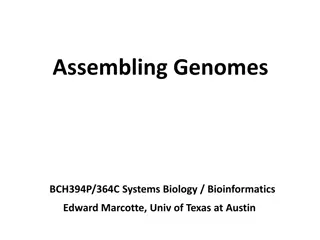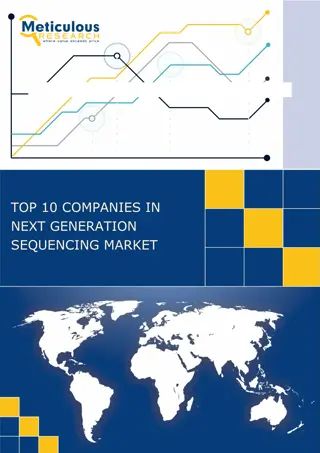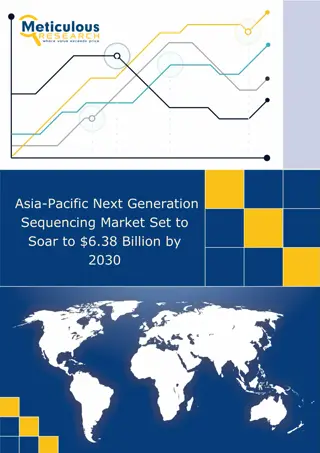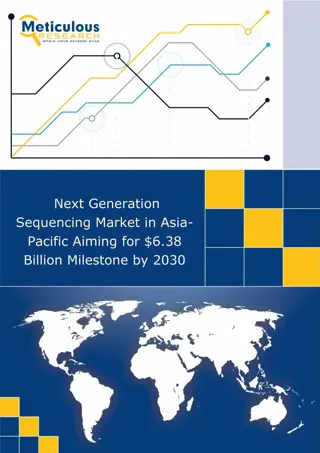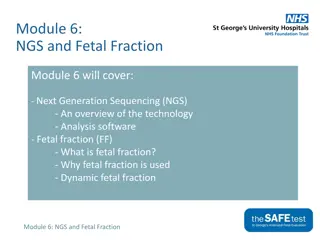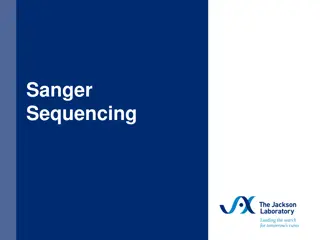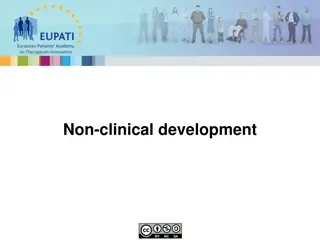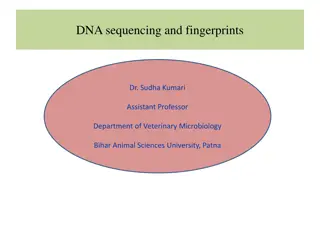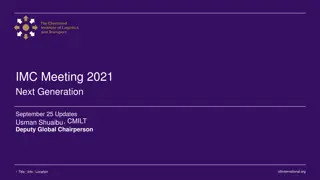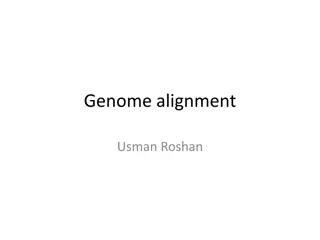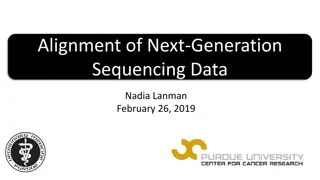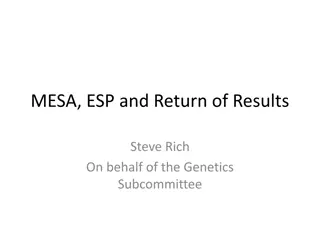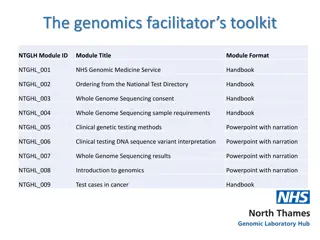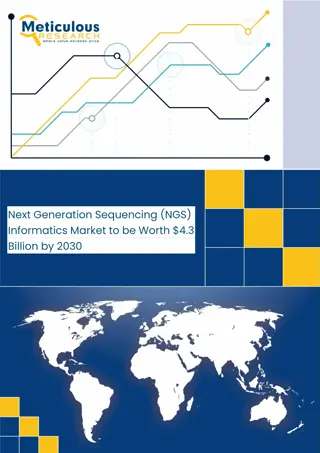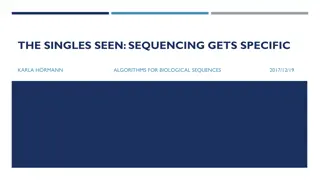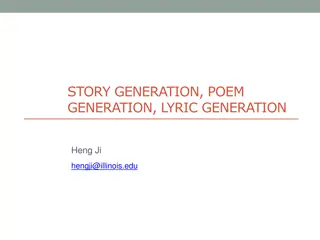Next-Generation Sequencing in Clinical Practice: Advancements and Applications
Next-Generation Sequencing (NGS) has revolutionized genetic analysis in healthcare. Dr. Alexandros Spyridonidis, a renowned expert in the field, discusses the impact of NGS on diagnostics, prognostics, and personalized medicine. The technology allows for more comprehensive understanding of diseases like Acute Myeloid Leukemia (AML) through targeted myeloid panels and large-scale genetic analysis. NGS offers a cost-effective and efficient approach to sequencing, enabling the detection of rare clonal cells and facilitating new diagnostic and prognostic classifications. With NGS, medical professionals can obtain valuable insights for clinical decision-making and patient care.
Download Presentation

Please find below an Image/Link to download the presentation.
The content on the website is provided AS IS for your information and personal use only. It may not be sold, licensed, or shared on other websites without obtaining consent from the author.If you encounter any issues during the download, it is possible that the publisher has removed the file from their server.
You are allowed to download the files provided on this website for personal or commercial use, subject to the condition that they are used lawfully. All files are the property of their respective owners.
The content on the website is provided AS IS for your information and personal use only. It may not be sold, licensed, or shared on other websites without obtaining consent from the author.
E N D
Presentation Transcript
: NGS ; Prof. Alexandros Spyridonidis, MD, PhD Head Bone Marrow Transplantation Unit, www.bmtpatra.gr Institute of Cell Therapy, www.ictpatras.gr CBMDP Donor Center, www.xarisezoi.gr MSc Cell and Gene Therapies, www.mastercgt.com University of Patras , Leader RIC Committee of Acute Leukemia WP JACIE Inspector CGT-GMP
COIs Disclosures (last and current year) advisory board membership travel support honoraria consultancy research support Disclaimers for this presentation honoraria Gilead, MSD, Novartis Amgen, Gilead, MSD, Menarini Amgen, MSD, Bristol, Genesis, Gilead Abbvie, Novartis, Prime View Takeda, Abbvie Genesis Pharma S.A
NGS - massively parallel sequencing Sanger sequencing: 1stgeneration slow and laborious >100 million USD in 2001 NGS: millions of small fragments of DNA are sequenced simultaneously < 10.000 USD in 2015 Illumina Thermo Fisher Scientific Pacific Bioscience Oxford Nanopore Technology SmidgION (ultra) deep sequencing NGS approaches enabling the detection of rare clonal cells comprising 1% or less of the original sample
NGS applications Whole genome sequencing (entire genome ~3B base pairs) Whole exome sequencing (~30M base pairs) Sequencing limited to protein coding regions representing ~1% of genome (Mutation panels)
Clinically important information is derived from large scale genetic analysis by WG- NGS: Cancer Genome Atlas Research Network (whole genome (50) or whole exome (150) sequencing)
NGS New diagnostic and prognostic classification (WHO 2016 and ELN 2017)
NGS AML Pathogenesis Eight functional categories of genes commonly mutated in AML DAT mutations CHIP
NGS targeted myeloid panels in every day clinical practice 30 Genes: Evangelismos Myeloid panel (Sophia Genetics) Hotspot genes: ABL1(4-9), ASXL1(9,11,12), BRAF(15), CALR(9), CBL(8,9), FLT3(13-15,20), HRAS(2-3),IDH1(4), IDH2(4), KIT(2,8-11,13, 17,18), KRAS(2,3), MPL(10), NPM1(10,11), NRAS(2,3),PTPN11(3,7-13), SETBP1(4), SF3B1(10-16), SRSF2(1), U2AF1(2,6), WT1(6-10) Full genes: CEBPA, CSF3R, DNMT3A, ETV6, EZH2, JAK2, RUNX1, TET2, TP53, ZRSR2, CNVs 38 Genes 37 Genes
NGS New GENETIC classification and stratification of AML The 5th edition of the World Health Organization Classification of Haematolymphoid Tumours: Myeloid and Histiocytic/ Dendritic Neoplasms. Leukemia (2022) 36:1703 1719; (Published online: 22 June 2022) International Consensus Classification of Myeloid Neoplasms and Acute Leukemias: integrating morphologic, clinical, and genomic data. Blood 15 SEPTEMBER 2022 | VOLUME 140, NUMBER 11 (prepublished online on Blood First Edition 29 June 2022.) Diagnosis and management of AML in adults: 2022 recommendations from an international expert panel on behalf of the ELN. Blood 22 SEPTEMBER 2022 | VOLUME 140, NUMBER 12, DOI 10.1182/blood.2022016867. (prepublished online on Blood First Edition 7 July 2022)
Do we need a comprehensive genetic characterization with Targeted NGS for AML? Expensive, may not be reimbursed by payers Time consuming Variants of unknown significance what to do? Some of the information is not currently actionable
NGS for everybody? Yes if this is translated into clinical valuable information
Case scenario- I Female 34 years Hb 6.9g/dl) , , 2% , , Ca . , https://www.ncbi.nlm.nih.gov/clinvar/ https://spliceailookup.broadinstitute.org https://gnomad.broadinstitute.org/
5thWHO Genetic AML diagnosis AML transformation of MDS and MDS/MPN continues to be defined under AML-MR in view of the broader unifying biologic features Most AML with defining genetic abnormalities may be diagnosed with <20% blasts. AML with defining genetic abnormalities AML defined by differentiation. AML, NOS is no longer applicable
NGS for diagnosis for a patient with AML fast NGS testing for clinically relevant biomarkers needed
Case scenario- II Male 54 years 4/2021 MDS, IPSSR Low Risk WBC: 3500/mmc, Hb: 11,9 gr/dl, PLT: 198.000/mmc FACS- : 2% -B : 46,XY, FISH : p53 negativ NGS-BM : U2AF1 17% 7/22 MDS/AML 6/9/2022 VUD PBSC Molecular International Prognostic Scoring System for Myelodysplastic Syndromes, NEJM Evidence June 2022
NGS for therapy decision (prognostic stratification)
Targeted therapy in frontline therapy: how precisely can we treat AML CT +midostaurin Quizartinib, gilteritinib, crenolanib (under investigation) FLT3 mutation CT ivosidenib/enasidenib (HOVON 150/AMLSG 29-18 trial) In chemotherapy-ineligible pts.: ivosidenib+azacytidine (IDH1m), venetoclax+HMAs (IDH1/2m) IDH1/2 mutation Prioritize clinical trials: eprenetapopt (APR-246), magrolimab TP53m Other subtypes/targets NPM1m AML: SYKi (entospletinib), KMT2A-r/PTD NPM1m AML Menin-inhibitor (JNJ-75276617, KO-539) Other targets CELMOD (CC-90009,CC-91633) MDM2i (HDM201, idasanutlin, ) BET bromodomain inhibitors SYKi (entospletinib, )
FLT3 rare variants: point mutations at JMD, FLT3i-resistant mutation at TKD1 (e.g., N676), rare variants at TKD2, Prognostic impact & response to FLT3 inhibitors? Heidel F, et al. Blood 2006;107:1761-9 Opatz S, et al. Blood 2013;122:293-300 Pauwels D, et al. Haematologica 2012;97:1773-4 Spiekermann K et al. Blood 2002;100:3423-5 Nguyen B, et al. Oncotarget 2017;10931-44
Is more precise therapy clinical relevant? RATIFY: Overall Survival Post-Transplant Treatment With MIDO Increases OS After SCT in CR1 SCT in CR1 HR 0.61 SCT outside CR1 HR 0.98 Midostaurin Placebo + Censor Stone RM, et al. N Engl J Med 2017; 377: 454-464.
The complex chronology & architecture of AML: expansion of pre-leukemic mutations (from CHIP to pre-leukemia), founding & subclonal mutations (AML onset), persisting (clonal remission) & emerging (relapse) L Ding et al. Nature 2011
Functional genomic landscape of AML (Beat AML): correlation of mutational events/gene mutation interaction/gene expression profile with drug sensitivity in vitro
NGS in mapping the molecular landscape of AML (research)
European Public-Private Partnership for Big Data in Hematology.
Patterns of mutual exclusivity of driver mutations revealed at single-cell level (vs. bulk profiling) Signalling mutations IDH1 & IDH2 mutation TP53 & PPMD1D Kiyomi Morita, et al. Nature Comm 2020; 11: 5327.
An unified classification and risk-stratification in AML: identification of a large MDS-like or secondary AML like category Performed in 3653 informative pts. (UK-NCRI & AMLSG) Yanis Tazi, et al. Nat Commun 2022;13:4622
Conclusions NGS is revolutionizing pathology and laboratory medicine Allows for true personalized medicine Facilitates use of targeted therapeutic strategies Costs are rapidly decreasing while the technology continues to improve Challenges remain Cost and reimbursement Data analysis Variant interpretation Today panels and genetically complex single gene analysis; detection of targeted structural variants Future routine comprehensive whole genome analysis
Do we need a comprehensive genetic characterization with Targeted NGS for all pts with AML? Yes in patients with intent to cure NSG translates into clinical valuable information Identification of germline predisposition mutations for (accurate) diagnosis For stratification (improved prognostic assignment) For (more precise) therapy (Identification of druggable targets) For therapy evaluation (MRD monitoring) Hints to track clonal evolution, (More rationale choice of therapy at relapse) For research (understanding high genetic heterogeneity, Inter- individual, Intraclonal)
Cell Therapy Program University of Patras The People FUNDING / SUPPORTERS DONORS


